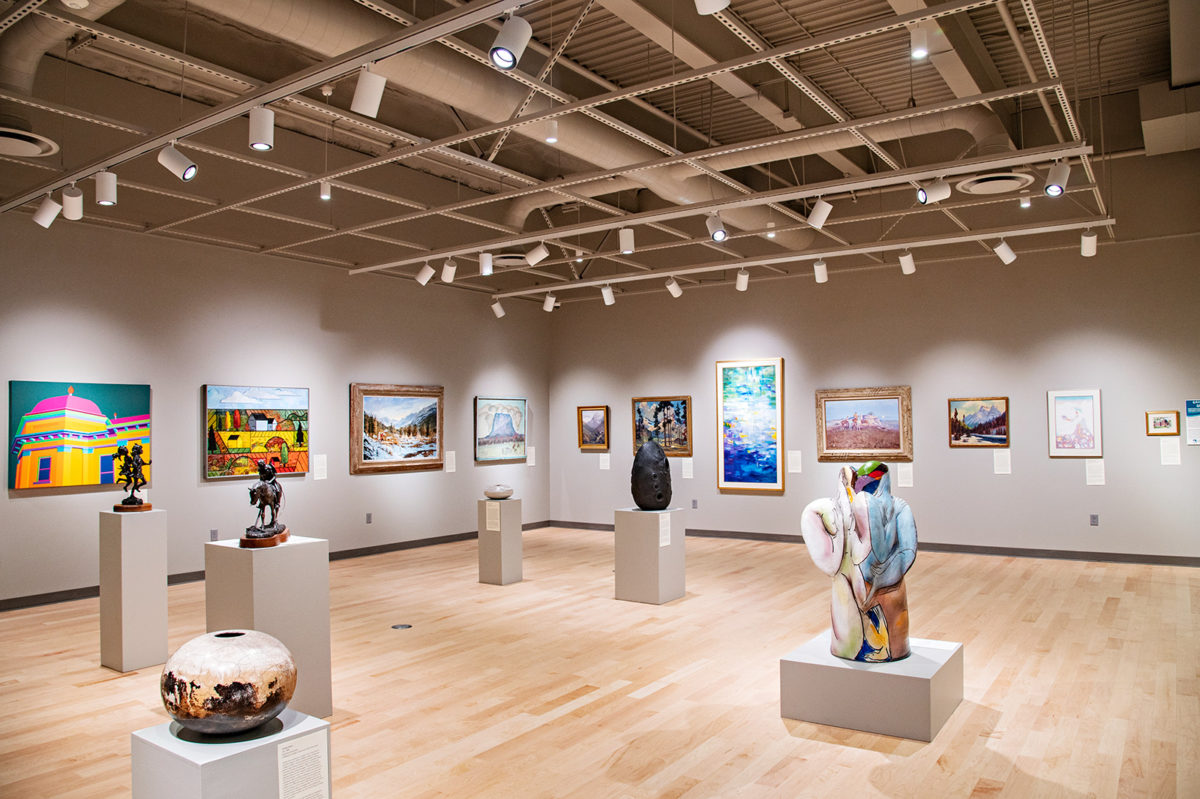The key link in the chain of events that led to the display of iconic works from renowned 15th and 16th century artists Rembrandt and Albrecht Durer at Flathead Valley Community College’s Wanda Hollensteiner Art Gallery is none other than Wanda Hollensteiner herself.
A local philanthropist, patron of the arts and musician who passed away in 2020, Hollensteiner’s generosity, including through the James and Wanda Hollensteiner Foundation, extended well beyond the boundaries of the Flathead Valley and encompassed Beloit College, her alma mater in Wisconsin where she studied psychology and art in the 1950s.
A significant moment in the legacy of Hollensteiner’s arts philanthropy came around 2009. Hollensteiner, who also has an art gallery at Beloit’s Wright Museum of Art named in her honor, provided a financial gift that year to support conservation efforts for items in the small college’s art collection, which includes around 6,000 objects accumulated going back to the late 19th century including works by Pablo Picasso, William Merritt Chase and Andy Warhol.
FVCC hosted a grand opening reception earlier this week for its new exhibit, “The Legacy of Wanda Hollensteiner,” which is made up of pieces collected by her family, friends and Beloit College. Among the first artwork attendees encounter in the gallery are the pieces by Durer and Rembrandt, as well as an undated piece called the “The Adoration of the Magi,” which is believed to be the product of the art school of Lucas Cranach, a famed 16th century German artist who was a friend of the theologian and printing innovator Martin Luther.
The new exhibit, which can be found inside the college’s new Wachholz College Center building on the lower floor, is free and open to the public from 12 p.m. to 4 p.m., Monday, Wednesday and Friday through Sept. 15, and will also be available for viewings by patrons to performances at the center over the same period. There are more than two dozen works of art on display in the exhibit. Included is the 19th century French painter Victor De Grailly’s oil on canvas depiction of George Washington’s tomb at Mount Vernon; 19th century American painter George Frederick Bensell’s 1875 painting “By the Falls”; 19th century French artist Henri de Toulouse-Lautrec’s lithograph “La Revue Blanche”; art from Ace Powell; and various works by Charlie Russell, including “Shadow Rider” and “Native American Warrior on Horseback.” Also included is a 1937 oil landscape painting by William Fraser, who was Wanda Hollensteiner’s maternal grandfather, and influential in cultivating her love of art.
As Wanda Hollensteiner’s husband, Jim, explained, among the art Wanda collected, she was especially attached to the painting by her grandfather, who died in 1942.

“He lived with Wanda and her parents during the Depression, along with eight other friends and relatives in a three-bedroom, one-bathroom home in Chicago,” Jim Hollensteiner said. “He painted this piece around age 77. The scene is of the family’s home in Nairn, Scotland, where he was born in 1860.”
The first piece to be restored at Beloit College about a decade ago was the Durer lithograph on display at FVCC, called “St. Jerome in His Study,” which dates back to 1514. Durer, an iconic German artist who was also known for his woodblock art and prints, had facilitated the reproduction of this particular piece of art by engraving the design, and it’s a piece that is associated with the emergence of printed images as major works of art.
The imagery is drawn from Renaissance art, and scholars have noted that Durer’s compositional approach in the piece was the byproduct of his commitment to using geometric principals in his work, including to create a sense of openness in the work. Beloit’s Wright Museum has published a series of books about its collection, and the above analysis is included in its 2019 collection of art scholarship called the “Wanda Hollensteiner Conservation Lectures.”

Li, the gallery director for FVCC’s Wanda Hollensteiner Art Gallery, explained that Durer’s reproduction of the concepts of the Italian Renaissance, combined with his ability to reproduce his work using various printmaking methods, allowed him to “spread the ideas that the Italian Renaissance had basically unleashed upon the world.”
Christa Story, an academic curator at the Wright Museum at Beloit College, said that while she was not there in 2010 when the Durer piece was delivered to Midwest Art Conservation Center to be worked on, the museum’s director has long been fond of describing the awed reaction from conservators as they saw what had been given over to their care.
“The MET has one, the British Museum has one,” Story said, adding that it’s not common for small academic museums in the Midwest to have a piece like “St. Jerome in His Study.”

Durer’s use of light and shadow in “St. Jerome in His Study” has also been lauded by scholars, so it’s only fitting that at FVCC’s Wanda Hollensteiner Art Gallery, it’s on the wall beside the work of Rembrandt, who is considered one of the most iconic manipulators of light and shadow in art.
Story said that the Rembrandt was among the most damaged pieces in the Beloit collection before it was worked on as part of Hollensteiner’s conservation program. Portions of the work, which is a 1636 print of an etching, and believed to be the final form of the work after a trio of revisions, had been damaged by water. The result was an almost rust-like stain likely due to the water’s mineral content, which left the Rembrandt etching in such bad shape that it was unfit for public display.
Called “Self Portrait with Saskia,” the piece shows Rembrandt in the foreground with his wife, Saskia van Uylenburgh, behind him, and, according to the Wright Museum’s Hollensteiner Lecture Series book, it was completed “when he was approaching an early summit in popularity, creativity, and wealth.”
As part of the exhibit at FVCC, Li has etching tools on display in an effort to convey both the process by which Rembrandt’s work was created, and the degree of skill required.
“When you see how delicate the lines are, this is what etching does. Etching is uniquely capable of reproducing these finer-than-a-hair lines, because it is such a beautifully delicate process,” Li said. “In the case of Rembrandt who is a total master of light, and dark, and chiaroscuro, and everything, you end up having the most delicate transitions of tone achievable by using these incredible intricate lines.”
Lucy Smith sits on the committee for the Wanda Hollensteiner Art Gallery at FVCC, and just this week it was announced that she had made a $500,000 donation for the college’s new Furlong Smith Fitness Center. She called herself a fan of the Hollensteiner family, who she said have inspired her with what they’ve given back to the Flathead. “Jennifer (Li) and I were talking about the transformative power of philanthropy because it not only gets to save and conserve art that takes us back for centuries,” Smith said. “But it also does allow for those extraordinary citizens of the community to participate in that.”
Credit:Source link


